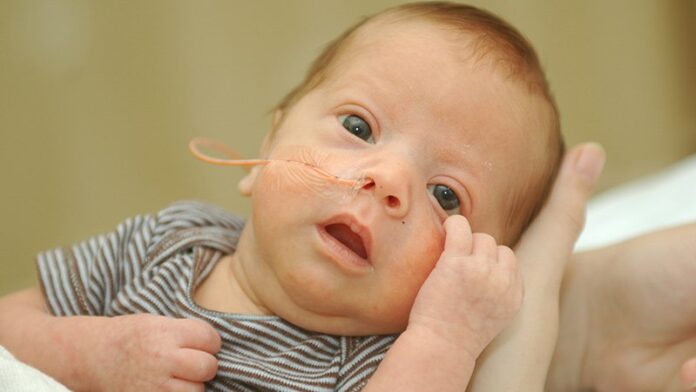[ad_1]
The advice of Vijay Srinivasan, MD, regarding enteral nutrition in children in critical care is simple: “feed early and feed well.”

Vijay Srinivasan
Srinivasan, a pediatric intensivist at Children’s Hospital of Philadelphia, laid out key evidence for that strategy on Tuesday at the Society for Critical Care Medicine (SCCM) 2021 Critical Care Congress.
Nutrition therapy is known to play a key role in helping children recover from chronic illness, but more recently it has become clear that it can shorten and tame the inflammatory response in acute illness, Srinivasan explained.
Without enteral nutrition (EN), the proinflammatory state of critical illness can lead to feeding intolerance, immune dysfunction, and organ dysfunction, he said.
Only one randomized trial has attempted to answer the question of optimal timing of EN in critically ill children, Srinivasan said.
In that study, 120 children in one Pediatric Intensive Care Unit (PICU) were randomized to either early EN (6–24 hours after admission) or late EN (more than 24 hours after admission). There was no significant difference in the length of stay — the primary outcome — between the groups.
Srinivasan’s group studied early EN in a secondary analysis of the Heart and Lung Failure-Pediatric Insulin Titration randomized controlled trial, and published the findings last March in Pediatric Critical Care Medicine.
“We observed that early EN was associated with lower ICU mortality,” he said.
In that analysis of 608 children, early EN was also associated with more days without ICU, more ventilator-free days, and less organ dysfunction, he said.
The largest study of EN in critically ill children was in 2014, Srinivasan said, and it retrospectively enrolled 5105 children from 12 PICUs to study the impact of early EN on PICU mortality.
Early EN in this study was defined as providing 25% of calories enterally over the first 48 hours of PICU admission.
Results show that children who received early EN were half as likely to die as those who did not (odds ratio, 0.51; P = .001.)
“Notably, an increasing proportion of EN relative to total energy at 48 hours was associated with significantly decreased mortality, suggesting a dose–response effect of early EN on survival,” Srinivasan said.
The recently published Surviving Sepsis guidelines favor early EN initiation, less than 48 hours after the identification of septic shock for children without contraindications to EN, Srinivasan noted. The guidance says EN should continue stepwise until nutritional goals are met.
All available evidence included in the SCCM and American Society of Parenteral and Enteral Nutrition (ASPEN) guidelines for nutritional support for critically ill children suggest early EN, 24–48 hours after PICU admission, for all eligible patients, Srinivasan said.
Early PN Not Recommended
However, although evidence supports early EN, outcomes for early parenteral nutrition (PN) have not been favorable.
A randomized controlled study in 2016 showed that there were more infections and longer hospital stays in the patients who got PN in the first 24 hours, as opposed to the first 7 days, after admission.
Given that evidence, “the SSCM and ASPEN guidelines for nutrition support therapy in critically ill children do not recommend early initiation of PN within 24 hours of admission,” Srinivasan explained, adding that “the optimal timing for initiation of parenteral nutrition remains unknown.”
He explained why early PN results appear to be worse.
“Based on preplanned secondary analyses, it appears that early intravenous amino acid exposure may be associated with considerable harm,” he told Medscape Medical News. “Early intravenous amino acid exposure appears to result in suppression of cellular autophagy — an extremely important process during the catabolic state of acute critical illness — as well as increased urea production resulting in liver and kidney dysfunction.”
He said the long-term effects of exposure to intravenous amino acids are less clear.
Srinivasan addressed the questions of how much energy to deliver and whether it should be exclusively EN or PN or a combination.
Once the acute phase turns to the chronic phase, traditional treatment has been to supplement EN with PN to prevent underfeeding and improve outcomes.
He highlighted a 2012 study that prospectively enrolled 500 subjects from 31 PICUs globally. The study showed that, contrary to expectations, increasing the delivery of energy as a combination of EN and PN was not associated with a lower 60-day mortality rate, but increasing energy with EN exclusively was.
To summarize: early EN is preferred in critically ill children as long as there are no contraindications.
“Once enteral nutrition is initiated, then a stepwise increase in energy and protein delivery to achieve goals of at least two-thirds energy needs and protein of more than 1.5 g/kg per day by about a week following admission to the ICU is highly desirable,” he said.
“If needed,” he added, “supplemental parenteral nutrition starting around 3 to 5 days into the ICU course can be selectively provided.”
Lauren Sorce, PhD, RN, codirector for clinical research in the PICU at Lurie Children’s Hospital in Chicago, told Medscape Medical News the directive to feed early and well is familiar in PICUs, but often is not top of mind in the rush to stabilize kids in shock, so Srinivasan’s talk was a good reminder.
“Once they become stable, it’s important for us to remember it’s time to start feeds,” she said.
She pointed out that this is a prime area for research as there are very few intervention studies done in pediatric nutrition. The level of evidence is often weak, so updated ASPEN and SCCM guidelines are essential tools for feeding strategies, she said.
Srinivasan and Sorce have disclosed no relevant financial relationships.
Society for Critical Care Medicine (SCCM) 2021 Critical Care Congress. Presented February 9, 2021.
Marcia Frellick is a freelance journalist based in Chicago . She has previously written for the Chicago Tribune, Science News and Nurse.com, and was an editor at the Chicago Sun-Times, the Cincinnati Enquirer, and the St. Cloud ( Minnesota ) Times. Follow her on Twitter at @mfrellick
For more news, follow Medscape on Facebook, Twitter, Instagram, and YouTube
[ad_2]
Source link












